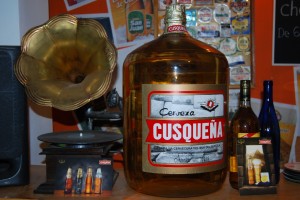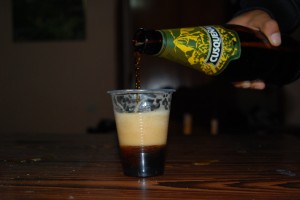Beer at the Heart of Cuzco’s Modern Life

Gold and white, a glass of Cuzco’s beer shines in most social events in Cuzco and is crossing new borders. With its exuberant taste it manifests an entire culture which makes the Cervecería Cusqueña brewery central to Cuzco’s life, from the fields of glowing oats to family gatherings and birthdays.
When the Spanish arrived in Cuzco they noted how chicha, a local brew made from corn and other grains, occupied a central place in Cuzco’s ceremonial, economic, and social life. Of course, with the changes and disciplines they sought to bring to indigenous life through colonialism they tried to stamp it out, though without much success.
However, after independence, when the British mercantilists pushed the railroad from the coast to the altiplano and then Cusco as a means to bring its resources to British imperial markets many other new cultural forms and people moved with the railroad and came to have importance for Cuzco’s life. Despite the importance of Great Britain it was the American, Henry Meiggs who was responsible for the railroad’s construction.
The railroad began construction in the latter half of the nineteenth century and finally reached Cuzco in 1908. That same year German immigrant Ernesto Gunther founded, along with a group of associates, what then was called the German brewery (Cervecera Alemana) and became the Cervecerìa Cusqueña. At the time, though Britain dominated the waves, German industry and know-how seemed without parallel; Germany and its culture seemed the pinnacle of modernity.
That is the official published history. But, Gunther’s company was part of the Cervecera Alemana founded a decade earlier in Arequipa and which along with the railroad made its way to Cuzco. Before the official founding of the Cervecería Alemana in Cusco, Gunther as of 1897 was already operating a brewery in Cuzco near La Recoleta. At that time there already were other breweries, such as Gustavo Mangelsdorff’s brewery in Anta, and one owned by Leoncio Vignes and Julio Ariansen in Saphi, as well as one owned by Froilan Cabrera.

Though the Cervecería Cuzqueña with its capital from Arequipa ovewhelmed these other breweries, nonetheless these brewers became important people in Cuzco. For example, Julio Ariansen was involved in the founding of Cuzco’s chamber of commerce in 1903.

Earlier, Ariansen had provided the beer which celebrated the founding of Cuzco’s soccer club, Cienciano. Soccer was another cultural form, along with beer, that arrived with the railroads. It and beer have grown together in Peru, such that today playing futbol, as soccer is called — especially the kind played on a small field called fulbito — is followed almost universally by “full-vaso” the drinking of beer, often until inebriated as suggested by the word “full” in Peruvian Spanish.
The production of beer in Cuzco required a transformation of its agriculture. Barley, from which beer is brewed, was not a traditional crop in the region, although now it can be found in much of the Vilcanota basin. In fall, as one rides from Cuzco to the pass at La Raya one can see many people pounding stacks of barley to extract the grains before winnowing them in the air. It has become a major crop and is thoroughly integrated in rural life.
Hops also had to be produced. And in 1911 the first plant to malt grains in Peru was opened in Cuzco.
Given beer’s association with modernity and the new sport of soccer — this sport is a major organizing force in male life in Cuzco from childhood to late adulthood — it quickly spread to become an important component of Cuzco’s social life. It became unsubstitutible in family and civic celebrations where it took much space away from chicha. Hardly an event takes place in Cuzco without a few brown bottles of Cerveza Cusqueña beer, or oftentimes a case or too.
Drinking beer is now part of ritual engagement with the earth. Before drinking a cup, people will raise it in “salud,” the clicking of glasses together while pronouncing good health to each other, and then a few drops are poured on the ground to share the drink with the pachamama, the lady of the earth.

Beer has become deeply rooted in Peruvian life such that it is the symbol of happiness and companionship. As a result there are many phrases associated with it. Bottles of beer are called “chelas”, “chilondrinas”, “helenas”, “un parcito no más”, and so on. Each phrase captures a set of meanings that are impossible to translate into English without writing paragraphs, but they strongly tie beer into Peruvian culture.
Finally, there is another phrase which emphasizes the ongoing reciprocity of drinking, where one person will fill their glass from the bottle before passing the bottle to the next person and drinking from their glass. Then the glass is passed and the ritual continues around and around until the bottle is empty. The people understand “él que la seca la llena” (he who dries out the bottle must fill it) which says that the person who finishes the bottle must buy a new one to keep the companionship going.
Though deeply rooted in Cuzco life and an axis of its economy, it has been many years since the Brewery was Cuzco owned. In its founding it involved capital from outside and so the Brewery has been part of the competition among other pPeruvian breweries and now is owned by the larges brewing company in Peru, Grupo Backus, named after another German who founded a brewery on the coast. Since then, the majority of Grup Backus’ shares have been acquired by a South African Brewer SAB Miller.
Nevertheless, the brand Cusqueña is one of the most popular in Peru and not just in Cuzco. It, along with the city for which it is named, is one of the symbols of Peru.
The capital involved in large manufacturing has allowed cusqueña beer to be exported. It can be found in many parts of the United States and Europe. The capital also allowed the beer to compete in international competitions where it has won many awards.

While Cuzqueña produces both a dark beer and a wheat beer, the standard cusqueña is a Pilsener style lager made with Czech Saaz hops and four different varieties of malts. A glass of cusqueña is an important part of the experience of this city that once was the capital of the Incas.





I read your article with great interest. Ernesto Gunther was my uncle, brother of my father Adolfo Gunther, both originally from Sorata, Bolivia. My parents had taken me for a visit to Cusco in the 1930s. My father was in charge of the Cerveceria Gunther & Tidow at the time, in Arequipa. I met Ernesto Gunther a few years later, in the early 1940s; he had come to our home in Lima for a visit, albeit briefly. I never saw him again. My family eventually moved to Buenos Aires. But the meeting with my uncle is still vividly on my mind, because he had been kind to me, a self-conscious youngster… I now live in Western Australia, am a former teacher of languages, a current author of books about the Nobel Prize and the winners thereof – and a nonagenarian.
Thank you for your comment and for the additional information. It is a pleasure to meet you through these pages. My apologies for the slowness in approving your comment and answering you. I have been very ill.